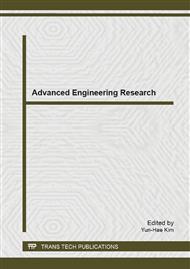[1]
C. T. Kresge, M. E. Leonowicz, W. J. Roth, J. C. Vartuli and J. S. Beck. Ordered mesoporous molecular sieves synthesized by a liquid-crystal te-mplate mechanism[J]. Nature,. Vol. 359(1992), p.710–712.
DOI: 10.1038/359710a0
Google Scholar
[2]
Y. Liu, W. Zhang and T.J. Pinnavaia, Steam-Stable. Aluminosilicate Mesostructures Assembled from Zeolite Type Y Seeds[J]. J. Am Chem. Soc, Vol. 122(2000), p.8791–8792.
DOI: 10.1021/ja001615z
Google Scholar
[3]
Y. Liu,W. Zhang and T.J. Pinnavaia, Steam‐stable MSU‐S aluminosilicate mesostructures assembled from zeolite ZSM‐5 and zeolite beta seeds[J]. Ange-w. Chem., Int. Ed, Vol. 40(2001. ), p.1255–1258.
DOI: 10.1002/1521-3773(20010401)40:7<1255::aid-anie1255>3.0.co;2-u
Google Scholar
[4]
Y. Han, D. Li, L. Zhao and F. S. Xiao, High‐Temperature Generalized Syn-thesis of Stable Ordered Mesoporous Silica‐Based Materials by Using Fluoroca-rbon–Hydrocarbon Surfactant Mixtures, [J]. Angew. Chem, Vol. 15 (2003), pp.3761-3765.
DOI: 10.1002/ange.200351466
Google Scholar
[5]
Sheldon M. Wiederhorn, Theo Fett, Gabriele Rizzi, Michael J. Hoffmann, Jean-Pierre Guin. Water Penetration—Its Effect on the Strength and Toughness of Sili-ca Glass[J]. Vol. 44(2013), pp.1164-1174.
DOI: 10.1007/s11661-012-1333-z
Google Scholar
[6]
M. Vallet-Regi , F. Balas, M. Colilla and M. Manzano, Bone-regenerative b-ioceramic implants with drug and protein controlled delivery capability[J]. Prog. Solid State Chem, Vol. 36 (2008), p.163–191.
DOI: 10.1016/j.progsolidstchem.2007.10.002
Google Scholar
[7]
V. Cauda,A. Schlossbauer and T. Bein, Bio-degradation study of colloida-l mesoporous silica nanoparticles: effect of surface functionalization with organo-si-lanes and poly(ethylene glycol)[J]. Microporous Mesoporous Material, Vol. 132(2010).
DOI: 10.1016/j.micromeso.2009.11.015
Google Scholar
[8]
A. Garcia, M. Colilla, I. Izquierdo-Barba and M. Vallet-Regi, Incorporation of Phosphorus into mesostructured silicas: a novel approach to reduce the SiO2 le-aching in water [J]. Chem. Mater, Vol. 21 (2009. ), p.4135–4145.
DOI: 10.1021/cm9012816
Google Scholar


